- Home
- About Us
- Industry
- Services
- Reading
- Contact Us
Fantasy Sports Market: Current Analysis and Forecast (2024-2032)
Emphasis on Sports Type (Football, Baseball, Basketball, Hockey, Cricket, and Others); Platform (Website and Mobile Application); Demographics (Under 25 Years, 25 to 40 Years, and Above 40 Years); and Region/Country
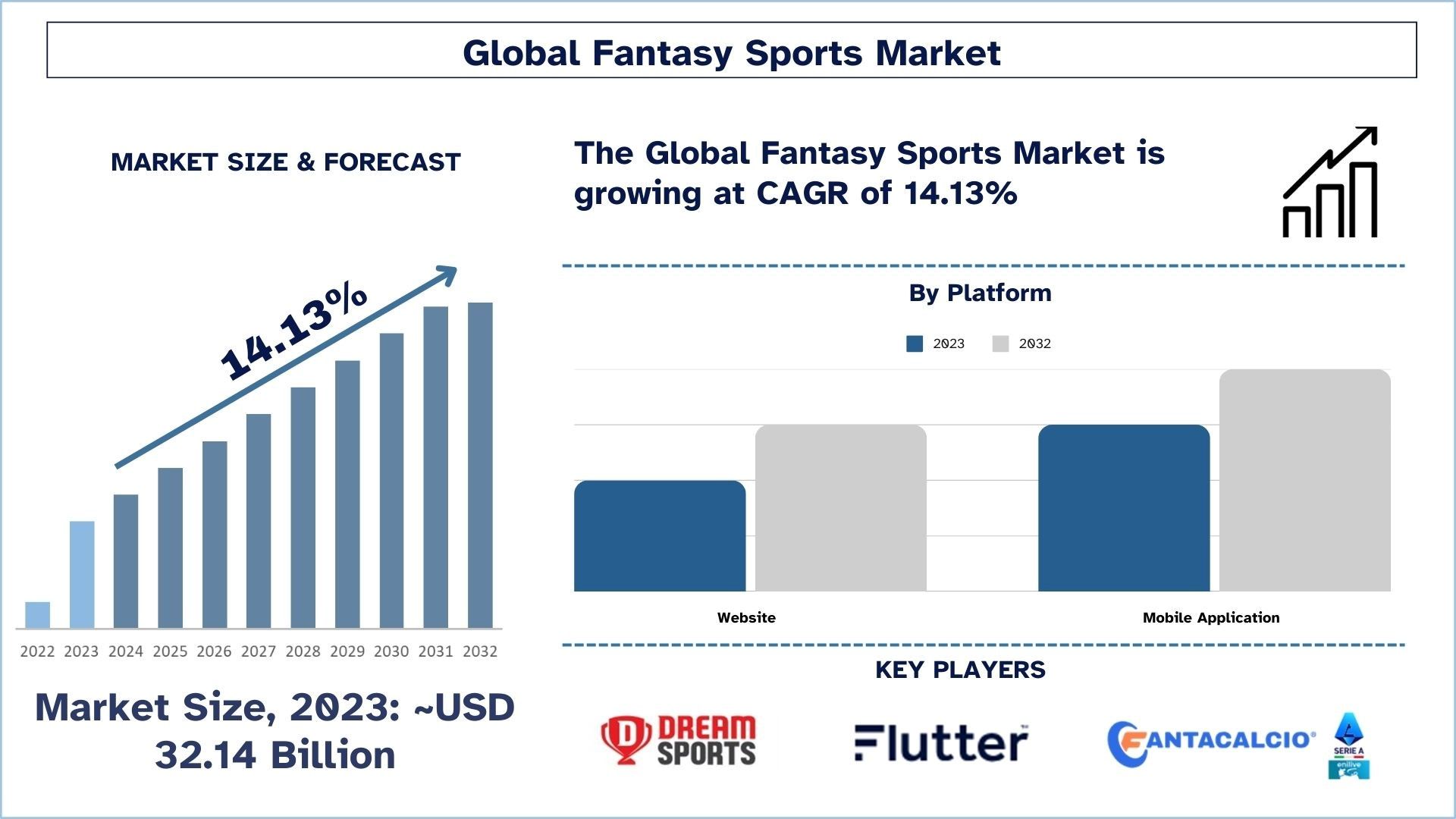
Global Fantasy Sports Market Size & Forecast
The global fantasy sports market was valued at USD 32.14 billion in 2023 and is expected to grow at a strong CAGR of around 14.13% during the forecast period (2024-2032) owing to the growing viewership of sports such as cricket, football, and basketball has expanded the user base for fantasy sports platforms.
Fantasy Sports Market Analysis
The global market of fantasy sports is a quickly developing segment where people use Internet-based services to create virtual teams with real-life players to compete based on real games. The drivers creating the potential for this market are the expanding consumption of Smartphones & internet facilities, zeal for sports, technological integration of Artificial Intelligence & data analytics for improved efficiency in user experience, and M&A by league sports with the facility providing Fantasy Sports platforms. The sense of sports consumption has increased over the years, along with the ability for promotion through social media platforms also plays a big role in growing the market.
Global Fantasy Sports Market Trends
This section discusses the key market trends that are influencing the various segments of the global Fantasy Sports market, as found by our team of research experts.
Mobile Application Segment Transforming Industry
The mobile application category is the largest contributor to the fantasy sports industry. This is mainly due to easy-to-use interfaces, real-time match tracking, and live updates that have made mobile applications the preferred choice for fantasy sports. Rising smartphone ownership, accessible data tariffs, and the development of such features as AI improve initiate rates and thus, the number of consumers, particularly in developing countries.
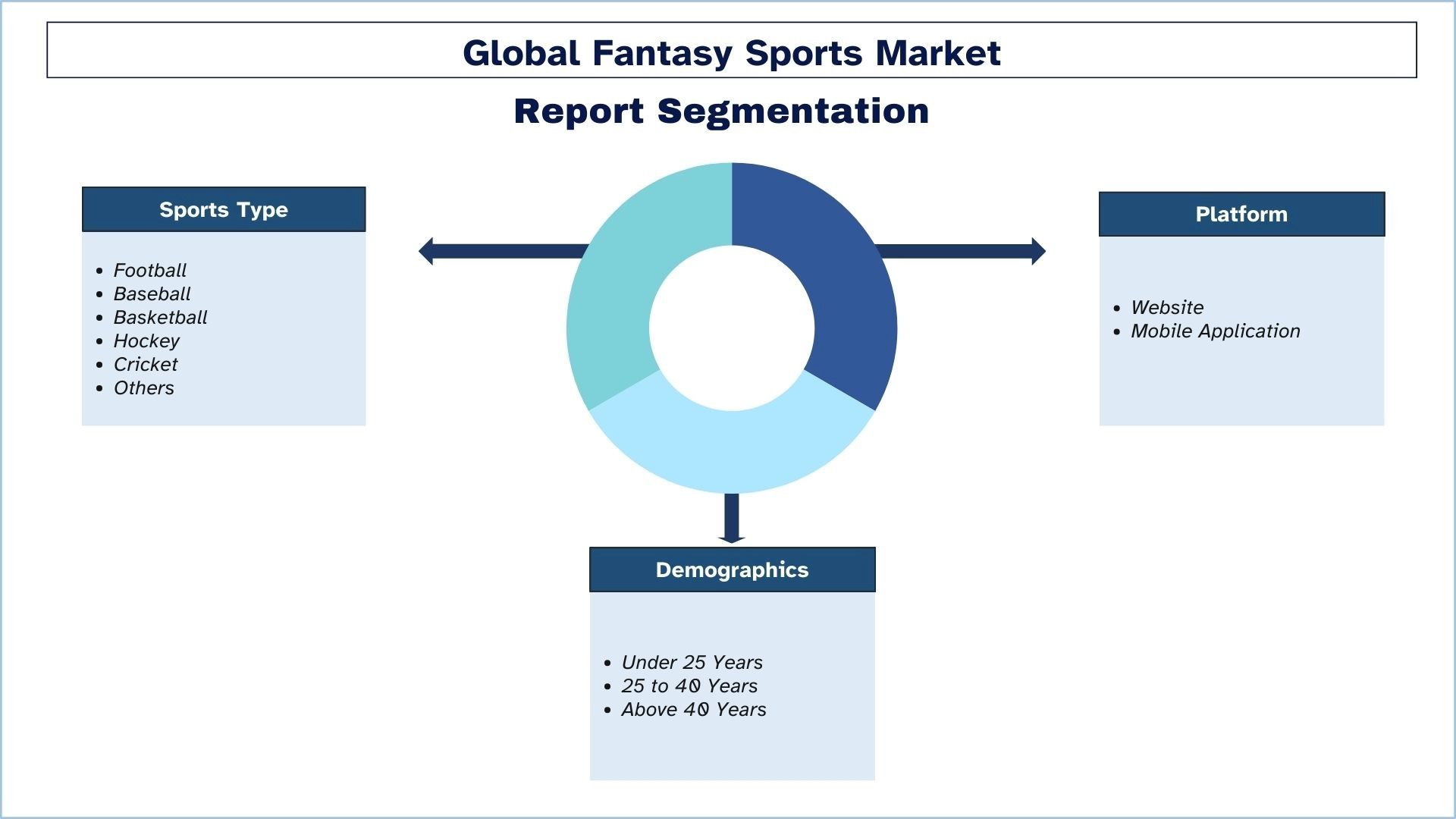
North America is expected to grow at a significant rate during the forecast period.
The North American market for fantasy sports has become the largest globally due to the availability of high internet connection, improved sports attitude, and strong techniques. A large and highly active population of players is situated in North America where many of them participate in the companies with the focus on platforms for football (NFL), basketball (NBA), baseball (MLB), and hockey (NHL). Continued legalization of the use of technology in sports betting in different states has extended market expansion, investment, and new products. Bonds with professional leagues, increased usage of mobile applications, and growing interest in Fantasy Sports have led North America to become the most dominant market in fantasy sports.
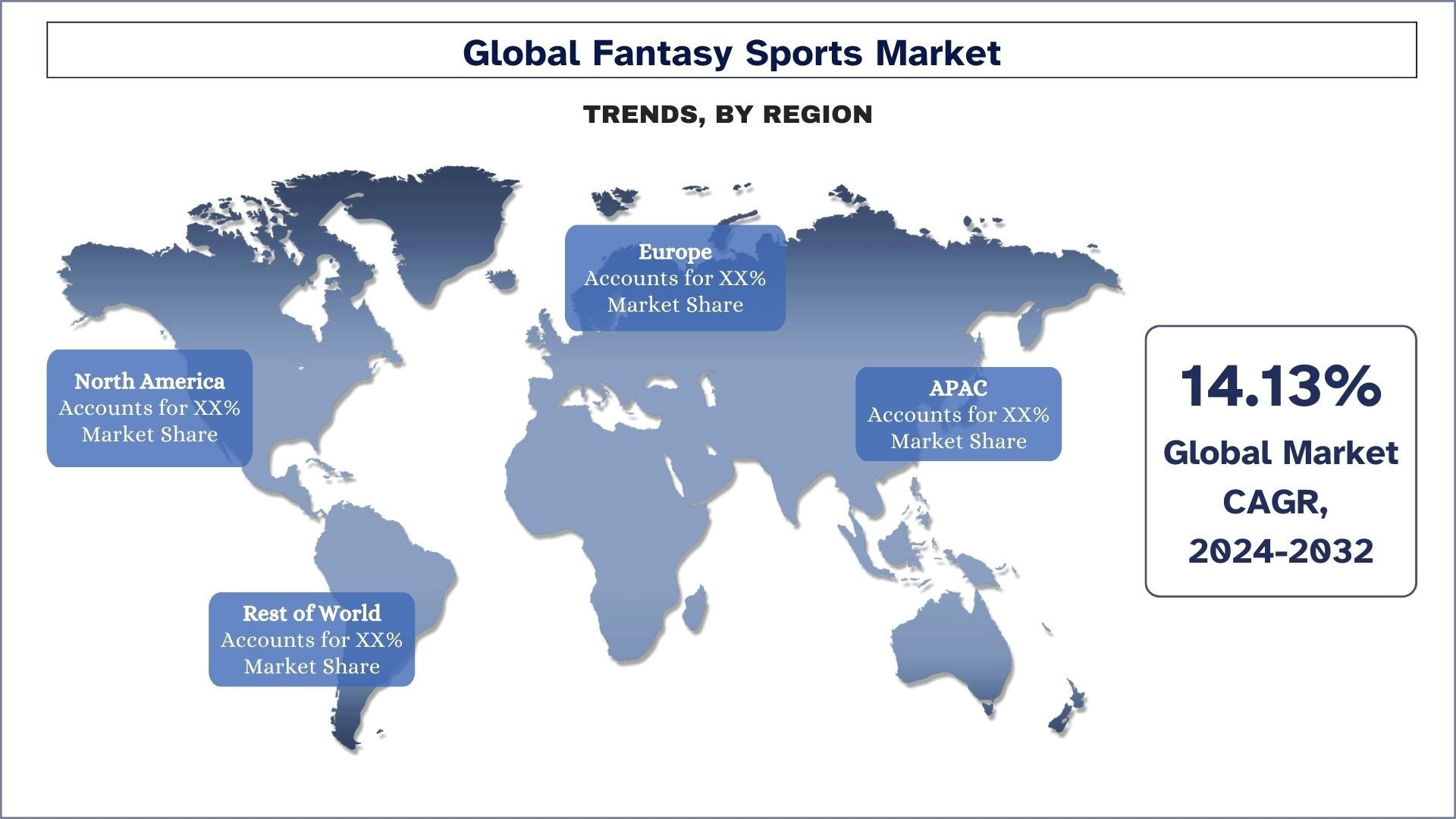
Global Fantasy Sports Industry Overview
The global fantasy sports market is competitive, with several global and international market players. The key players are adopting different growth strategies to enhance their market presence, such as partnerships, agreements, collaborations, new product launches, geographical expansions, and mergers and acquisitions. Some of the major players in the market are Dream Sports Group; Quadronica; Flutter Entertainment; Rotoworld (NBC Sports); FantasyPros; DraftKings Inc.; Fantrax; NFL Enterprises LLC; CBS Interactive (Paramount Streaming); Low 6 Limited
Global Fantasy Sports Market Report Coverage
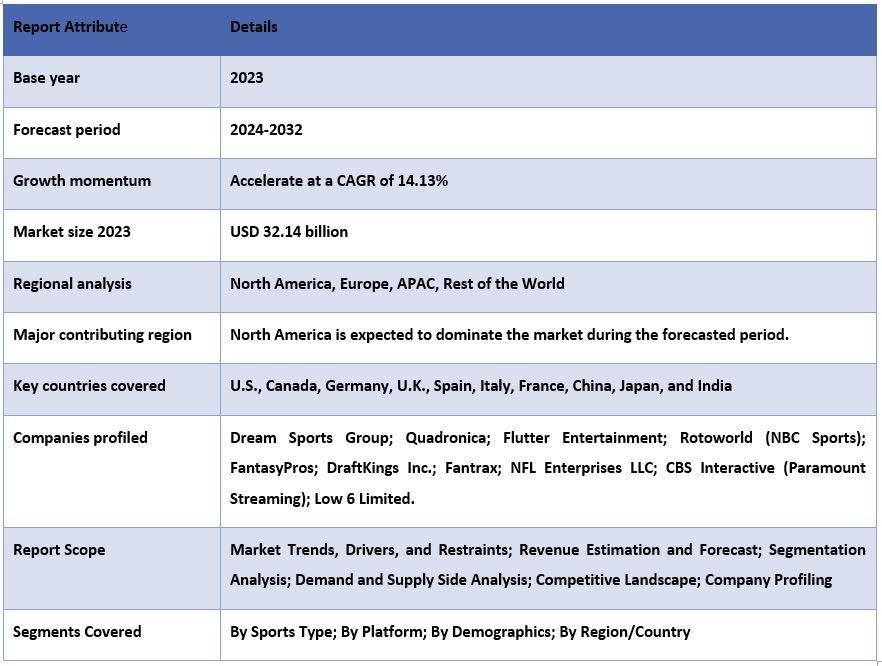
Reasons to buy this report:
The study includes market sizing and forecasting analysis confirmed by authenticated key industry experts.
The report briefly reviews overall industry performance at one glance.
The report covers an in-depth analysis of prominent industry peers, primarily focusing on key business financials, type portfolios, expansion strategies, and recent developments.
Detailed examination of drivers, restraints, key trends, and opportunities prevailing in the industry.
The study comprehensively covers the market across different segments.
Deep dive regional level analysis of the industry.
Customization Options:
The global fantasy sports market can further be customized as per the requirement or any other market segment. Besides this, UMI understands that you may have your own business needs, hence feel free to contact us to get a report that completely suits your requirements.
Table of Content
Research Methodology for the Global Fantasy Sports Market Analysis (2024-2032)
Analyzing the historical market, estimating the current market, and forecasting the future market of the global Fantasy Sports market were the three major steps undertaken to create and analyze the adoption of global Fantasy Sports in major regions. Exhaustive secondary research was conducted to collect the historical market figures and estimate the current market size. Secondly, to confirm these insights, numerous findings and assumptions were considered. Moreover, exhaustive primary interviews were conducted with industry experts across the value chain of the global Fantasy Sports market. For the assumption and validation of market numbers through primary interviews, we employed a top-down/bottom-up approach to forecasting the complete market size. Thereafter, market breakdown and data triangulation methods were adopted to estimate and analyze the market size of segments and sub-segments of the industry. The detailed method is explained below:
Analysis of Historical Market Size
Step 1: In-Depth Study of Secondary Sources:
A detailed secondary study was conducted to obtain the historical market size of the global Fantasy Sports market through company internal sources such as annual reports & financial statements, performance presentations, press releases, etc., and external sources including journals, news & articles, government publications, competitor reports, third-party database, and other credible publications.
Step 2: Market Segmentation:
After obtaining the historical market size of the global Fantasy Sports market, we conducted a detailed secondary analysis to gather historical market insights and share for different segments & sub-segments for major regions. Major segments are included in the report, such as sports type, platform, demographics, and region. Further country-level analysis was conducted to evaluate the overall adoption of testing models in that region.
Step 3: Factor Analysis:
After acquiring the historical market size of different segments and sub-segments, we conducted a detailed factor analysis to estimate the current market size of the global Fantasy Sports market. Further, we conducted factor analysis using dependent and independent variables such as sports type, platform, demographics, and global Fantasy Sports market regions. A thorough analysis of demand and supply-side scenarios was conducted considering top partnerships, mergers and acquisitions, business expansion, and product launches in the global Fantasy Sports market.
Current Market Size Estimate & Forecast
Current Market Sizing: Based on actionable insights from the above 3 steps, we arrived at the current market size, key players in the global Fantasy Sports market, and market shares of the segments. All the required percentage shares split and market breakdowns were decided using the above-mentioned secondary approach and were verified through primary interviews.
Estimation & Forecasting: For market estimation and forecast, weights were assigned to several factors including drivers & trends, restraints, and opportunities available for the stakeholders. After analyzing these factors, relevant forecasting techniques, i.e., the top-down/bottom-up approach were applied to arrive at the market forecast for 2032 for different segments and sub-segments across the major markets globally. The research method adopted to estimate the market size encompasses:
The industry’s market size, in terms of revenue (USD) and the adoption rate of the global Fantasy Sports market across the major markets domestically
All percentage shares, splits, and breakdowns of market segments and sub-segments
Key players in the global Fantasy Sports market in terms of the types offered. Also, the growth strategies adopted by these players to compete in the fast-growing market.
Market Size and Share Validation
Primary Research: In-depth interviews were conducted with the Key Opinion Leaders (KOLs) including Top Level Executives (CXO/VPs, Sales Head, Marketing Head, Operational Head, Regional Head, Country Head, etc.) across major regions. Primary research findings were then summarized, and statistical analysis was performed to prove the stated hypothesis. Inputs from primary research were combined with secondary findings, hence turning information into actionable insights.
Split of Primary Participants in Different Regions
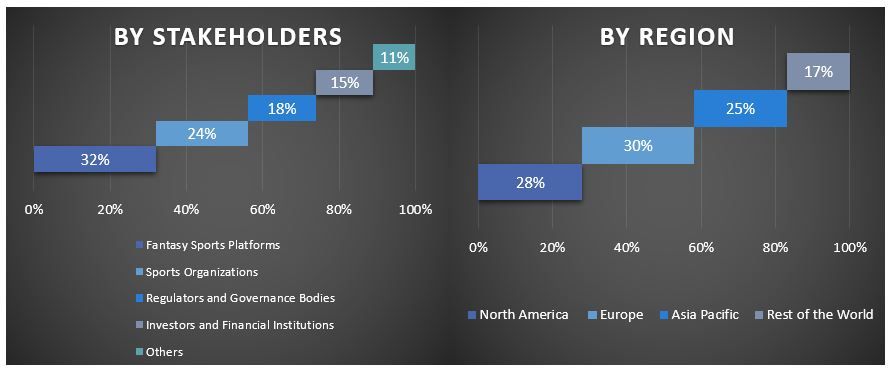
Market Engineering
The data triangulation technique was employed to complete the overall market estimation and to arrive at precise statistical numbers for each segment and sub-segment of the global Fantasy Sports market. Data was split into several segments and sub-segments after studying various parameters and trends in the global Fantasy Sports market's sports type, platform, demographics, and regions.
The Main Objective of the Global Fantasy Sports Market Study
The current & future market trends of the global Fantasy Sports market were pinpointed in the study. Investors can gain strategic insights to base their discretion for investments on the qualitative and quantitative analysis performed in the study. Current and future market trends determined the market's overall attractiveness at a regional level, providing a platform for the industrial participant to exploit the untapped market to receive help from a first-mover advantage. Other quantitative goals of the studies include:
Analyze the current forecast and market size of the global Fantasy Sports market in terms of value (USD). Also, analyze the current forecast and market size of different segments and sub-segments.
Segments in the study include areas of sports type, platform, demographics, and regions.
Define and analyze the regulatory framework for the industry.
Analyze the value chain involved with the presence of various intermediaries, along with analyzing customer and competitor behaviors of the industry.
Analyze the current and forecast market size of the global Fantasy Sports market for the major regions.
Major countries of regions studied in the report include Asia Pacific, Europe, North America, and the Rest of the World
Company profiles of the global Fantasy Sports market and the growth strategies the players adopt to sustain the fast-growing market.
Deep dive regional level analysis of the industry
Frequently Asked Questions FAQs
Q1: What is the global Fantasy Sports market’s current market size and growth potential?
The global fantasy sports market was valued at USD 32.14 billion in 2023 and is expected to grow at a CAGR of 14.13% during the forecast period (2024-2032).
Q2: What are the driving factors for the growth of the global Fantasy Sports market?
Integration of artificial intelligence and machine learning has enhanced user experience by providing data analytics and personal recommendations.
Q3: Which segment has the largest global fantasy sports market share by sports type category?
The football category has the largest share of the global fantasy sports market by sports type segment.
Q4: What are the emerging technologies and trends in the global fantasy sports market?
Integration of Augmented Reality (AR) and Virtual Reality (VR) in fantasy gaming is an emerging technology in this industry.
Q5: Which regions dominate the global Fantasy Sports market?
North America is expected to dominate the market during the forecast period.
Related Reports
Customers who bought this item also bought










